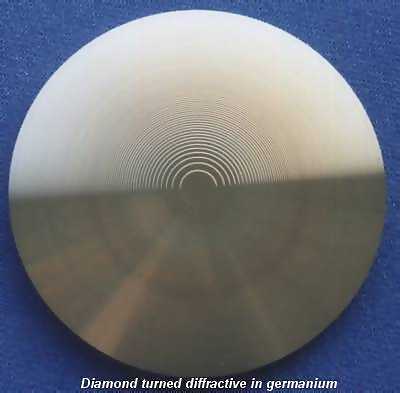Diffractive Optics
Athermalize IR Systems
The properties of materials employed in infrared lenses generally
exhibit significant variations with changes in ambient temperature. As a
result, the control of thermally induced degradation in image quality is
an important issue in optical systems operating at infrared wavelengths.
These include the objective lenses of thermal imagers and the optics
employed in CO2 laser-machining systems.
Precision-Optical Engineering
in Hitchin, Hertfordshire, England, has developed hybrid
refractive-diffractive lenses for passive athermalization of the optical
components of thermal imagers. They are generally in the form of a
conventional aspheric lens with a blazed zone plate diffractive
structure superimposed on the non-spherical surface. Development of room
temperature staring-array sensors operating over the 8 to 14um range
offers the potential of lightweight, low-cost and compact thermal
imagers. This requires optical systems that emphasize a given level of
performance with the minimum number of elements.
The typical lens system
comprises two germanium elements, the front one being an asphere in a
Petzval-type arrangement. This type of lens maintains acceptable optical
performance over a range of a few degrees Celsius about the ambient,
though the lens may be required to perform over -20 to +40 'C.
Typically, this discrepancy is accommodated by manual adjustment of the
focus. Precision-Optical Engineering has developed an athermalized
version of this Petzval-type lens that maintains lens performance over
the full operating temperature range.
This component replaces the
front germanium aspheric element with a doublet that comprises a
negative germanium hybrid element and a positive spherical AMTIR or zinc
Selenide component. While the lens doublet stabilizes operation over a
wide temperature range, the diffractive surface controls the resulting
primary longitudinal chromatic aberration, a particularly important
consideration in this design. Although secondary spectrum is typically
larger in hybrid lens systems than in equivalent conventional designs,
the germanium AMTIR doublet results in a very small level of this
aberration, and near-diffraction-limited performance can be achieved
on-axis. A similar hybrid solution not employing a diffractive surface
would require an additional lens material and therefore four lens
elements.
The diffractive surface
contains about 25 zones over a diameter of 75 mm and can be readily
manufactured with high diffraction efficiency by single-point diamond
turning, according to Precision-Optical Engineering. The performance of
such a lens has been assessed in the laboratory over the full operating
temperature range and matches well with theoretical predictions.
The thermal focus shift
introduced into lenses by high-power CO2 laser-machining operations can
also significantly degrade system performance. Precision-Optical
Engineering uses a diffractive surface in this case to directly cancel
the thermal defocus introduced by a conventional refractive lens. The
result is a diffractive structure with many more zones (100 to 200) than
are typically required in hybrid optics employed for the correction of
chromatic aberrations.

Reprinted from the February
1995 issue of PHOTON lCS SPECTRA © Laurin Publishing Co., Inc.
|